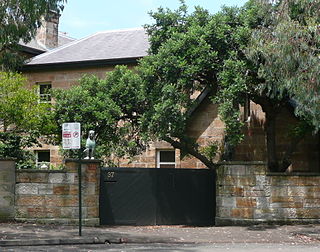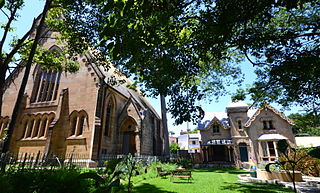
Kingston Lacy is a country house and estate near Wimborne Minster, Dorset, England. It was for many years the family seat of the Bankes family who lived nearby at Corfe Castle until its destruction in the English Civil War after its incumbent owners, Sir John Bankes and Dame Mary, had remained loyal to Charles I.

Tyntesfield is a Victorian Gothic Revival country house and estate near Wraxall, North Somerset, England. The house is a Grade I listed building named after the Tynte baronets, who had owned estates in the area since about 1500. The location was formerly that of a 16th-century hunting lodge, which was used as a farmhouse until the early 19th century. In the 1830s a Georgian mansion was built on the site, which was bought by English businessman William Gibbs, whose huge fortune came from guano used as fertilizer. In the 1860s Gibbs had the house significantly expanded and remodelled; a chapel was added in the 1870s. The Gibbs family owned the house until the death of Richard Gibbs, 2nd Baron Wraxall in 2001.

Attingham Park is an English country house and estate in Shropshire. Located near the village of Atcham, on the B4380 Shrewsbury to Wellington road. It is owned by the National Trust and is a Grade I listed building.

Wellington is a market town and a civil parish in the borough of Telford and Wrekin, Shropshire, England. It is situated 3 miles (4.8 km) north-west of Telford town centre and 12 miles (19 km) east of Shrewsbury; the summit of The Wrekin lies 3 miles south-west of the town. The population of the town was 25,554 in 2011.

Rippon Lea Estate is a heritage-listed historic house and gardens located in Elsternwick, Melbourne, Victoria, Australia. It is in the care of the National Trust of Australia. It was added to the Australian National Heritage List on 11 August 2006.

Benthall Hall is a 16th-century English country house in Benthall in the town of Broseley, Shropshire, England, and a few miles from the historic Ironbridge Gorge. It retains much of its fine oak interior, and an elaborate 17th-century staircase. It is still occupied by the Benthall family, but has been owned by the National Trust since 1958, and is open to the public every Monday, Tuesday, Wednesday, Saturday, Sunday and Bank Holiday Monday.

Maplelawn is an historic house and former estate located in Ottawa, Ontario, Canada. The house was built between 1831 and 1834 as the centre of a farming estate by the Thomson family. In 1877 the Cole family bought the estate and lived there until 1989. The house is now owned by the National Capital Commission and it is a designated national historic site. It is particularly noted for the well preserved and rare walled garden next to the house, The Maplelawn Garden. Since 1999 the Maplelawn has been the location of the Keg Manor restaurant. Today the house is located in Westboro at 529 Richmond Road.

Cound is a village and civil parish on the west bank of the River Severn in Shropshire, England. It is 7 miles south east of Shrewsbury.

Vaucluse House is a heritage-listed residence, colonial farm and country estate and now tourist attraction, house museum and public park, formerly the home of statesman William Charles Wentworth and his family. It is located at 69a Wentworth Road, Vaucluse in the Municipality of Woollahra local government area of New South Wales, Australia. Completed between 1803 and 1839 in the Gothic Revival style, its design was attributed to W. C. Wentworth and built by Sir Henry Browne Hayes and W. C. Wentworth. The property is owned by the Historic Houses Trust of New South Wales, an agency of the Government of New South Wales. The site was added to the New South Wales State Heritage Register on 2 April 1999.

Smeaton is a village and country estate in East Lothian, Scotland. It is off the B1407, near East Linton, and very close to Prestonkirk Parish Church as well as the National Trust for Scotland properties Preston Mill and Phantassie Doocot.

Tresco is a heritage-listed residence located at 97 Elizabeth Bay Road, Elizabeth Bay, City of Sydney, New South Wales, Australia. It was designed by Thomas Rowe and built by Rowe from 1867 to 1883. The property is privately owned. It was added to the New South Wales State Heritage Register on 2 April 1999. The property has previously functioned as a private residence, navy housing, and homestead and was originally indigenous lands. Before 2004 it was owned by the Royal Australian Navy and served as an official residence for the senior naval officers in New South Wales.

The Davenport House, also known as Sans-Souci, is an 1859 residence in New Rochelle, New York, designed by architect Alexander Jackson Davis in the Gothic Revival style. The "architecturally significant cottage and its compatible architect-designed additions represent a rare assemblage of mid-19th through early 20th century American residential design". The house was listed on the National Register of Historic Places in 1980.

Reussdale is a heritage-listed former private house and now function centre located at 160 Bridge Road in the inner western Sydney suburb of Glebe in the City of Sydney local government area of New South Wales, Australia. It was designed and built by Ferdinand Reuss from 1868 to 1870. It is also known as the former Presbyterian Manse. The property is privately owned. It was added to the New South Wales State Heritage Register on 2 April 1999.

Snead is a small village in Powys, Wales.

Whepstead is a heritage-listed villa at Main Road, Wellington Point, City of Redland, Queensland, Australia. It was designed by architect Claude William Chambers and built in 1889 by Patrick Horisk. It is also known as Bay View Private Hospital and Fernbourne. It was added to the Queensland Heritage Register on 21 October 1992.
Toongla is a heritage-listed former residence and dairy farm and now residence at 41 Tullimbar Road, Albion Park in the City of Shellharbour local government area in the Illawarra region of New South Wales, Australia. It was built during 1873. The property is privately owned. It was added to the New South Wales State Heritage Register on 2 April 1999.

Riverview House is a heritage-listed former orchard and now residence at 135 Marsden Road, West Ryde in the City of Ryde local government area of New South Wales, Australia. It was built from 1860 to 1878 by George Spurway. The property is privately owned. It was added to the New South Wales State Heritage Register on 2 April 1999.

Stanmore House is a heritage-listed residence at 88 Enmore Road, Enmore, Inner West Council, New South Wales, Australia. It was built from 1847 to 1855, with the design attributed to Henry Robertson. It is also known as Pemell House. It was added to the New South Wales State Heritage Register on 2 April 1999.

Hampton Villa is a heritage-listed residence at 12b Grafton Street, Balmain, Inner West Council, New South Wales, Australia. It was built c. 1847-1849 by Edward Hunt; the design is uncertain, but has been attributed to John Verge. Among its notable residents was Henry Parkes, tenant from 1888 to 1892. The villa replaced an earlier building known as Hampton Cottage. It was added to the New South Wales State Heritage Register on 27 May 2005.

Lyndhurst is a heritage-listed residence and former school, laundry, maternity hospital and industrial building located at 61 Darghan Street in the inner western Sydney suburb of Glebe, New South Wales, Australia. It was designed by John Verge and built from 1833 to 1837. The property is owned by Historic Houses Trust of New South Wales. It was added to the New South Wales State Heritage Register on 2 April 1999.































